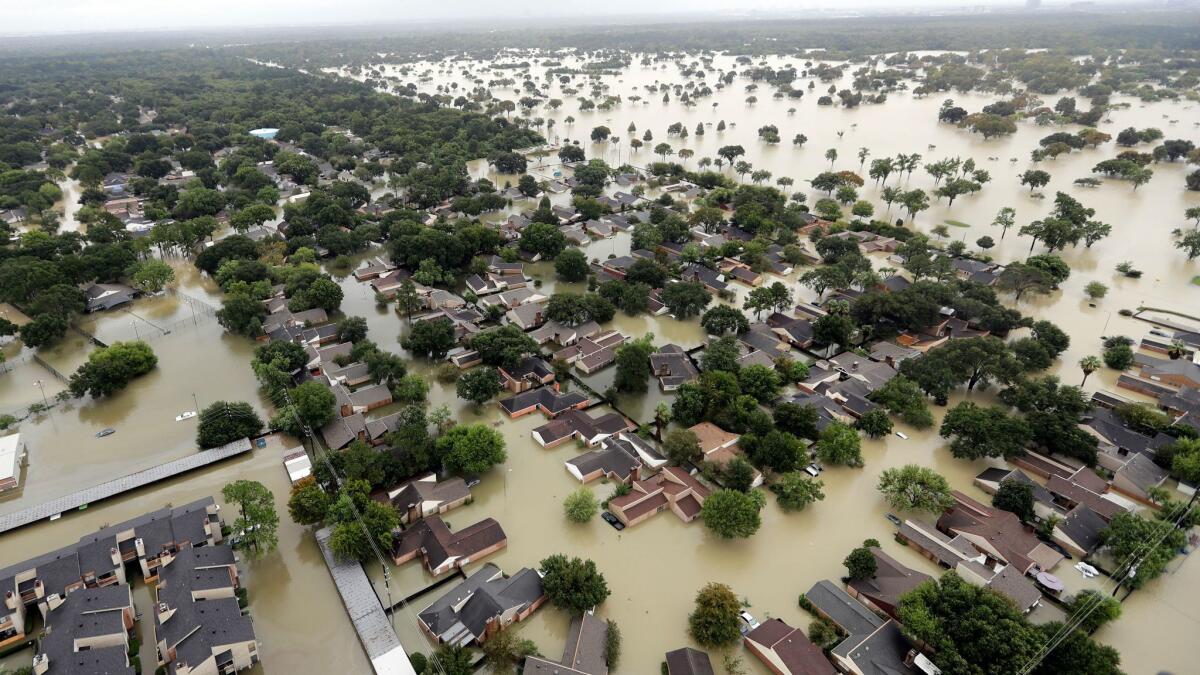Op-Ed: Now’s the time to talk about flood insurance, and moral hazard

Q: What do you call a congressman who votes against emergency aid for hurricane victims?
A: A “piece of … .”
Sure, the Northern Kentucky Chamber of Commerce later apologized for that particular characterization of the libertarian-leaning Rep. Thomas Massie (R-Ky.), who was one of just three members of the House of Representatives brave and/or foolish enough to vote against the $7.85-billion Hurricane Harvey relief bill. But generally speaking, this is how the public treats heretics who oppose blank checks during times of crisis.
That’s a shame because the Scrooges have a point, even if you don’t share their (and my) concern over a national debt that zoomed past the $20-trillion mark last week. The fact is that existing government policy encourages too many people to live in harm’s way.
For nearly 50 years, the federal government has administered the National Flood Insurance Program, which allows millions of property owners in flood-prone areas to purchase protection against water damage at below-market rates. More than half of the beneficiaries live in — of all places! — Florida and Texas.
There’s no compelling reason for South Dakota to bail out South Beach.
The NFIP, which is administered by the Federal Emergency Management Agency, was nearly $25 billion in debt even before hurricanes Harvey and Irma. Only through periodic bailouts can the fund keep its anti-actuarial promises. And, as The Times delicately phrased it in a recent news article, “The cheap rates have also confused some homeowners about the risk of flooding in their neighborhood.”
Economists have been telling us for decades that prices are a way of conveying information, and individuals tend to respond to incentives. It doesn’t require an advanced degree to reckon just how people will respond to the incentive of artificially inexpensive insurance rates in dangerous but attractive locales.
“While there is an imperative for the government to provide assistance in time of crisis,” Kevin Starbuck, the former emergency management coordinator for the city of Amarillo, Texas, asserted in a December 2016 Homeland Security Affairs paper, “that assistance may change behavior; policies designed to limit risk may actually prolong or increase risk.” Welcome to the concept of moral hazard.
This being government, politics also tend to get in the way. No office-holder wants to be the one to tell existing property owners that their holiday from the free market is over. For that reason, homeowners were “grandfathered” in at unreasonably low rates when FEMA first drew up its flood insurance rate maps and guaranteed access to coverage.
The result is as grisly as you would expect: 3.8% of policyholders have filed for repetitive losses, accounting for a disproportionate 35.5% of flood loss claims and 30.5% of claim payments, Starbuck said. Of those serial recipients, FEMA estimates that a jaw-dropping 90% pay grandfathered rates. Every new calamity, and every new check-writing flurry from the feds, perpetuates a dumb system.
California is no stranger to government-insurance policies gone horribly wrong. In 1968, the same year that brought us the National Flood Insurance Act, Congress brought into existence Fair Access to Insurance Requirements, which made government the property insurer of last resort in places insurance companies wouldn’t touch, such as riot-scarred inner cities. Over time, almost as if to illustrate the concept of mission creep, FAIR policies in California clustered disproportionately in rich, fire-prone regions such as Malibu.
These bass-ackward incentives are glaringly obvious to almost everybody who has studied the government’s disaster-area insurance guarantees. Yet they persist, mutate and even grow. Why?
Because nobody likes to be called a piece of … .
So maybe it’s time to flip the script. Congress and President Trump just extended the National Flood Insurance Program — which had been scheduled to run out at the end of this month — until Dec. 8. That gives the Legislature plenty of time to, at minimum, put an end to grandfathered rates.
But the longer-term solution is staring us right in the face. Let the market, not some hustlers trying to win reelection, determine how to price insurance in floodplains, fire belts and along earthquake faults. Stop socializing other people’s siting decisions. There’s no compelling reason for South Dakota to bail out South Beach.
“I don’t think now is the time to debate those things,” White House Homeland Security advisor Tom Bossert told reporters in the midst of Hurricane Harvey. But Bossert has it wrong. Because we tend to pay attention to catastrophes only when they happen, it behooves us in those moments to fix broken policy before the next one hits.
Make Harvey and Irma our last blank checks, and from here on out, have people pay their own freight for living dangerously. It’s time we separated our disaster policy from Shinola.
Matt Welch is editor at large of Reason, a magazine published by the libertarian Reason Foundation, and a contributing writer to Opinion.
Follow the Opinion section on Twitter @latimesopinion or Facebook
More to Read
A cure for the common opinion
Get thought-provoking perspectives with our weekly newsletter.
You may occasionally receive promotional content from the Los Angeles Times.






